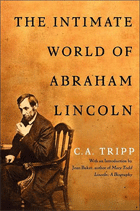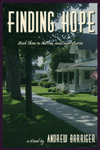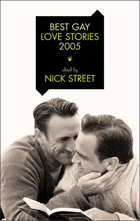 Tony
Heyes, our man from England, reviews three books this issue. The Intimate World of Abraham Lincoln
is our featured title this issue, and Tony handles the subject with his
usual panache and good sense. Tony also reviews the latest in the Tom
and Taylor series by Andrew Barriger, Finding Hope. And finally,
Tony takes a look at a smart short-story collection, Best Gay
Love Stories 2005, edited by Nick Street.
Tony
Heyes, our man from England, reviews three books this issue. The Intimate World of Abraham Lincoln
is our featured title this issue, and Tony handles the subject with his
usual panache and good sense. Tony also reviews the latest in the Tom
and Taylor series by Andrew Barriger, Finding Hope. And finally,
Tony takes a look at a smart short-story collection, Best Gay
Love Stories 2005, edited by Nick Street.If you would like Tony to review a book, please contact him here.
  The Intimate World of
Abraham Lincoln by C.A. Tripp The Intimate World of
Abraham Lincoln by C.A. TrippPublished by Free Press 2005 ISBN: 0-7432-6639-0 Before Alfred C. Kinsey produced his deafening reports, more was known about the sexual behaviour of homing pigeons than that of human beings. Young ladies of a refined disposition were advised to lie back and think of England (or wherever) on their wedding night, such was the depth of their ignorance. What followed was usually a surprise, pleasant or unpleasant as the case may be. Kinsey’s investigations have been blamed by many for the sexual revolution. Whether “blame” is the right word is a moot point. Certainly those findings demonstrated beyond all doubt that what many thought of as their own peculiar secrets were neither peculiar nor confined to them. The concept of normality suddenly went way beyond heterosexual horizontal jogging. Neither fidelity nor the male/female missionary position could ever again be claimed to be universally applicable. That they ever were thought to be is testimony to the amazingly myopic attitude of received western wisdom. Had those responsible for society’s mores raised their eyes to look at other, perhaps Polynesian or African, societies they would have seen that morality is largely socially determined. The late C.A. Tripp, the author of The Intimate World of Abraham Lincoln, was one of Kinsey’s research assistant. According to Kinsey’s biographer, James H. Jones, he was given the job of recruiting two thousand young men to be filmed masturbating to climax to settle a dispute about the dynamics of ejaculation. Apparently he had no difficulty finding recruits. Young men were queuing round the block as if for the opening of a blockbuster movie. Whether they performed their onerous task motivated by a burning zeal for the advancement of scientific knowledge or by the fee of two dollars is not made clear. What can be said with certainty is there’s nowt so queer as folk. Armed with his Kinseyan beliefs, Tripp turned his attention to the case of Abraham Lincoln to settle the dispute about his sexual orientation and emotional attachments. He finished the book just before he died in 2003. It is to be regretted that he drags in Kinsey’s conclusions, particularly about the onset of puberty, since they are not particularly relevant. The evidence, such as it is, speaks for itself. Any self-respecting historian would come to conclusions similar to Tripp’s without the use of Kinsey’s approach. Kinsey’s influence on Tripp was quite profound, however, and must be taken into consideration in assessing Tripp’s book. Tripp focuses on several aspects of Lincoln’s life and character: his known aversion to female company, his reluctance to marry, his “softness” and courtesy, his aversion to games and violence and his known attraction to young men. Further, not only is he known to have slept with his bosom friend for four years, long after there was any economic need to, he slept with a soldier in the White House when Mrs. Lincoln was away. Although his union with his wife was blessed with issue, theirs was a notoriously less than ideal marriage. Mr. Tripp marshals the evidence for Lincoln’s proclivities and also examines, and dismisses, his alleged relationships with other women before he was finally caught by the future Mrs. Lincoln. As can be expected, at so great a distance in time the evidence is not watertight. We can never know what Lincoln got up to in bed. We will never know how he saw himself. Even if we did it would be difficult to transpose that self-awareness into intelligible modern concepts since the whole notion of homosexuality as a psychological state is a modern construct. Nevertheless, despite his ideological baggage Mr. Tripp makes a convincing case for Lincoln’s homo-social disposition and emotional attraction to his own sex. The probabilities converge to suggest that were he alive today he would not be with his fellow Republican successor in denouncing the gay community. This is a thought-provoking and well researched book. |
  Finding Hope Finding Hope by Andrew Barriger Published by Two Brothers Press 2004 ISBN 1-59457-678-5 Opening a novel by Andrew Barriger is rather like opening a box of Belgian chocolates. You have to carry on until you’re finished. They are so eminently and irresistibly readable. It was with pleasurable anticipation that I began Mr. Barriger’s latest offering and he does not disappoint. Finding Hope is the third novel, in what is rapidly turning into a series, about Taylor Connolly and Tom McEwan. It is set in the enviably pleasant small town of Pine Creek. In the previous two stories, Finding Faith and Finding Peace, Taylor and Tom find each other after pursuing a rather circumspect relationship, set up house and adopt a family in tragic circumstances. Along the way they rescue and take in a troubled young man, Wayne McInerney, who is the victim of family abuse. (Is it coincidental that the three main characters have Celtic surnames, one wonders.) Their unbounded optimism and generosity enable them to rise above adversity, helped by the large commission Taylor received as a result of successfully pursuing a sexual harassment claim against a big corporation. Finding Hope takes up the story two years on from the ending of Finding Peace. Rather surprisingly Eric Driskell, the partner of their friend Wayne, who is by now their unofficially adopted “son” and business manager, has gone back to Ohio to complete his university education, leaving Wayne bereft and desolate. He has offered no proper explanation of why he has done this and although they have kept in touch with each other, Wayne doesn’t know whether they are still an “item” or not. This is the least credible part of the story and I must confess to being unconvinced by Eric’s subsequently revealed reasons. Eric’s fears are credible; his reasons for not confiding in Wayne less so. That apart, the story is extremely absorbing, crowded with incident and very enjoyable. Gen Pouissant, Taylor’s best friend, has become mayor. Taylor’s law firm is flourishing and the bakery, run by Tom and Wayne, is also doing well. Tom has become a professor at the college Wayne attends. They are all working flat out. Two spanners are thrown into the works: a property developer moves into town and is standing for mayor and Eric turns up on Wayne’s doorstep, pitching Wayne into emotional confusion. The burden of the novel is the resolution of Wayne’s dilemma and the unfolding of the political and legal machinations involved in fending off the sleazy property developer. The four main male characters, Taylor and Tom, Wayne and Eric, aided by a newcomer, Jason, seek to stymie the developer, in the process expanding their business empire by acquiring property he is interested in. On the personal level, Wayne is pulled up short by Eric’s being involved in an accident. This forces him to confront his feelings. He has fed on his own fears, having been made timorous and unsure by the abuse to which he has been subjected in the past. He realises that the resentment he has built up against Eric is as nothing compared to the depth of the love he feels for him. Their relationship resumes. Meanwhile, Taylor is busy coaching Gen for the forthcoming mayoral election. After a public debate between the two candidates, the issue is suddenly resolved by a monumental mistake on the part of Gen’s opponent. Meanwhile, Jason begins a relationship with a colleague of Tom that goes nowhere. At the end of the book another character enters who looks promising. Mr. Barriger handles all the strands in the story with great skill and brings most of them to a very satisfying conclusion. There are two obvious loose ends: Eric’s rocky relationship with his father remains problematic, and Jason’s love life is non-existent. Perhaps these issues will be addressed in a sequel? All in all, Finding Hope can be thoroughly recommended to anyone who wants to read a life-enhancing tale. |
  Best Gay Love Stories
2005 Best Gay Love Stories
2005Edited by Nick Street Alyson Books 2005 ISBN: 1-55583-881-2 Love is the sweetest thing. Love hurts. Love is a many-splendoured thing. Love is strange. Love is my reason for living. Love ... you get the picture? No topic has exercised song-writers, poets and novelists more. Some publishers devote their entire output to romantic fiction. Until now, though, few gay authors have written love stories, pure and simple. Most gay novels, reflecting their authors’ experiences, have been tales of concealment, anxiety and strife. Now, finally, we are beginning to see the light. We can take off our corsets and spread out. Now same-sex romance can be regarded as normal – one is tempted to say as blueberry pie (but won’t) – and we can luxuriate in reading stories in which “they all lived happily after.” Well, almost. It’s good to read a tale that is uplifting, encouraging and reassuring and if that means it’s escapist, all well and good. Best Gay Love Stories 2005, edited by Nick Street, provides a selection of tales that are, in the main, stories of requited love. Mr. Street has assembled works from the four corners of the English-speaking world. For those of us reared on stories of suicidal despair this is in itself a welcome occurrence. Several of the authors will be familiar to regular readers of gay fiction. It would be tedious to march the reader through the stories awarding them, as it were, marks out of ten. However, it can be said with confidence that most of the stories in this collection are either entertaining or thought provoking. Several of the stories are purely whimsical. Passing, by J.A. Deveaux, is a ghost story tinged with pathos whilst Lawrence Schimel’s Märchen to a Different Beat is an updating of a fairy tale, conflating the stories of Hansel and Gretel and Cinderella to bring a young boy his Prince Charming at a school dance. There is a sprinkling of stories of unrequited love or relationships going awry, such as Jim Gladstone’s Pop Music and David Masello’s To Another City. Tom Mendocino’s Meet the Wilkinses and GaryMcCann’s The Best I Can Do under the Circumstances show that love does not always last or is fulfilling. My personal favourites are the stories that hold out hope or make a point. Visiting, as I do, my mother who is in her tenth decade (and before anyone asks, she had me very, very late in life) in a residential home every week, I can’t help but wonder what happens to gay people who have to end their days in such places. Steve Attwood’s A Man’s Man offers one possibility and shows how we must be prepared. Rhysenn S’s The Law of Love, Lou Dellaguzzo’s The Feast and Bob Condron’s Adam and Steve show how love can grow in a variety of circumstances. This does not exhaust all the stories and the ones not mentioned are excellent too. A collection of stories by so many very different authors could easily be uneven and patchy. Mr. Street is to be congratulated for showing such skill in choosing so many of such high quality. The authors themselves should be similarly commended for their prowess. Anyone choosing to buy this collection will not be disappointed. Too often story collections contain a certain amount of filler. Here that is not the case. Time and money expended on getting and reading this highly recommendable book will not be wasted. |